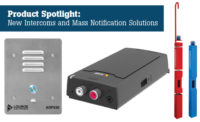Report Highlights Growth of Mass Notification Systems

A new report shows how mass notification technology has become mission-critical for a broad array of businesses, agencies and institutions.
The survey, conducted by Disaster Resource GUIDEand sponsored by MIR3, said that survey respondents pointed to ease-of-use, reliability, features and pricing as the primary factors to influence purchase decisions. Other important factors include feature set, with real-time reporting and synchronization to other databases ranking highly.
According to the report, the emergency mass notification systems (EMNS) primary users among those with deployed systems included emergency management, business continuity, IT and disaster recovery. Of those with an EMNS deployed, over 90% included North America in their operating region. Forty-six percent of survey respondents did not have a notification system in place at the time of the survey along with the 14% that stated they are actively seeking a solution. Most EMNS solutions provided global support with a range from 11% for Africa to 30% for Europe. While the median employee size was 1,000 to 5,000, more than 33% of the systems were deployed in organizations with more than 10,000 employees.
EMNS solutions are clearly recognized as necessary systems across all verticals, the report said, though some industries have greater rates of adoption than others, according to the report. Among those with systems already in operation, the largest sector was Financial Services, representing almost 25% of participants. Second and third place sectors were Government (13.3%) and Health, Pharmaceuticals, Biotech (12.1%). Approximately 8% of replies were from Energy and Education.
Organizational size was, as might be expected, the report said, towards the high-end of the survey scale with 73% of participants with deployed systems more than 1,000 employees and 33% with more than 10,000 employees. Across all sectors, smaller (<1,000 employees) organizations represent a larger percentage. Within this survey it was encouraging to note that 9% of those with systems deployed had fewer than 100 employees and 27% had less than 1,000 employees.
The majority of deployed systems (94%) supported North American operations, with Europe the second most supported region at 30%, the report said. Globally deployed systems also had significant support worldwide, with 22% of systems supporting Asia-Pacific and high teen percentages for three additional regions: Australia, Middle East and South/Central America.
Among companies with deployed systems, the average number of years they have had a system of any sort in operation was six years, with more than 18% of survey participants from organizations with more than ten years of experience with an EMNS.
The most important criteria cited by respondents as the basis for choosing their currently deployed system was usability, followed closely by features. Price was the third criteria cited as the basis for selection. Integration with other existing database systems in use within the organization was a close fourth in the list.
Most systems were primarily focused on employee communication, but a number of systems incorporated external groups of recipients as well. Among deployed systems, 68% included notification to all employees as critical for their needs. Contractors, first responders and community and/or citizens were the next three highest use categories. Less than 10% of systems were used for other groups like vendors, suppliers, students and parents or family.
Looking for a reprint of this article?
From high-res PDFs to custom plaques, order your copy today!





